
The results of the main KPIs for voice tests achieved by operators, split per aggregation type are presented in Figure 1.
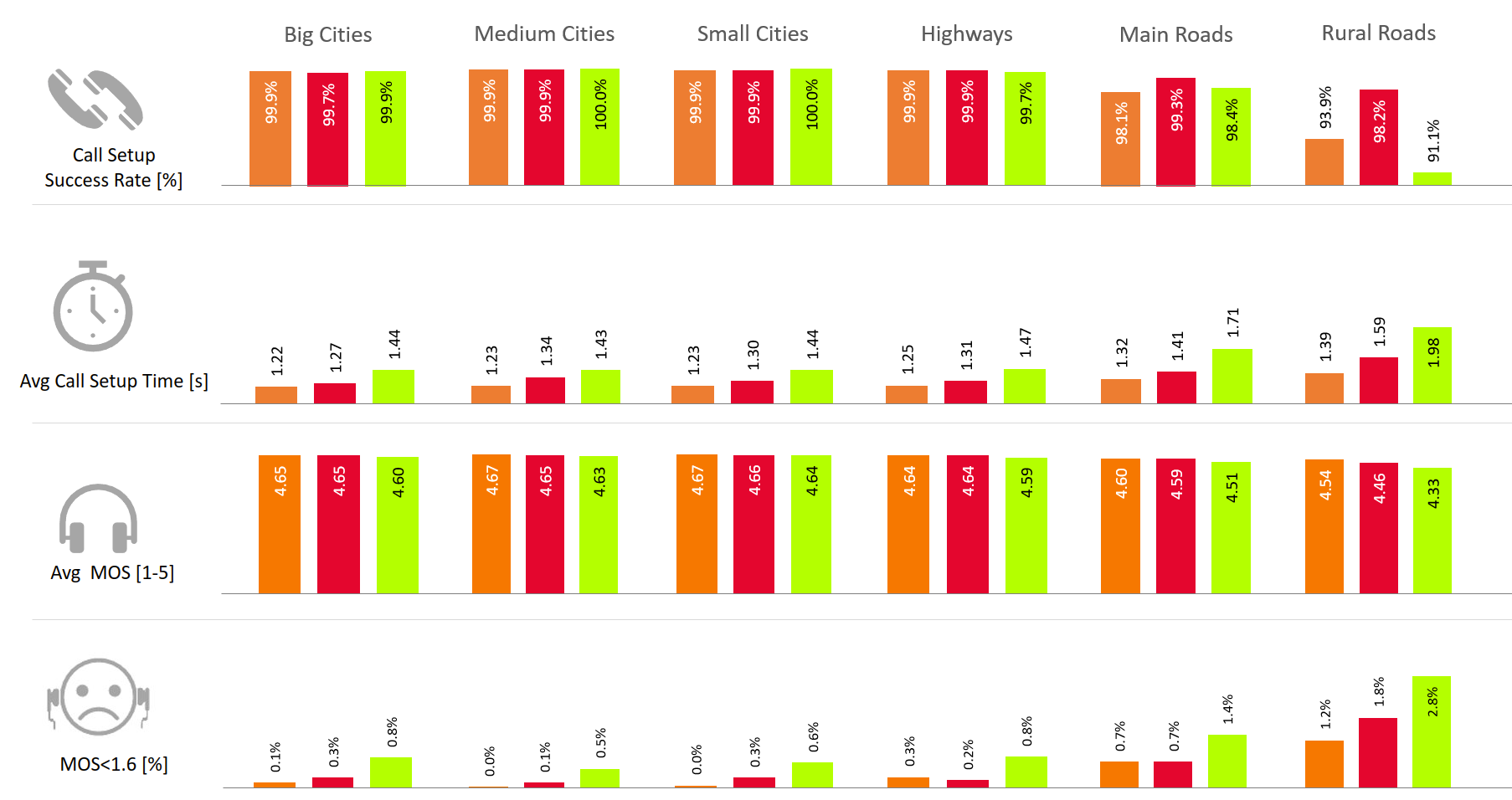
Fig. 1. Results of main KPIs for voice tests
Big Cities:
All operators achieved excellent session success rates. Telekom Srbija and A1 Srbija had the shortest call setup times and had the highest average MOS results. Yettel was slightly behind the competitors.
Medium Cities:
Similarly to the Big Cities, all operators achieved excellent session success rates. A1 Srbija took the lead in the shortest average call setup time and higher average MOS than Telekom Srbija and Yettel.
Small Cities:
Again, all operators achieved excellent session success rates. A1 Srbija had the shortest average call setup time and the highest average MOS. Telekom Srbija was right behing A1 and Yettel had slightly worse results.
Highways:
Success rates are still at an excellent level for all three operators. A1 Srbija had the shortest call setup time and the highest average MOS which is the same for Telekom Srbija. Yettel slightly behind the competitors.
Main Roads:
Telekom had the best average success rate on main roads aggregation. A1 Srbija had the shortest average call setup time, Telekom Srbija was second and Yettel last, but all very good. Telekom Srbija and A1 Srbija were almost equal with MOS results, followed by Yettel.
Rural Roads:
Telekom Srbija still had the best success rate on rural roads. As expected, in the rural areas the average MOS values are lower than in other aggregations. A1 Srbija had the higher average MOS and the shortest call setup time than the competitors.
In Table 1, voice failed calls and dropped calls scores for all three operators, in different aggregations, are shown.

In Big Cities all operators achieved good results. A1 Srbija and Yettel had single failed calls.
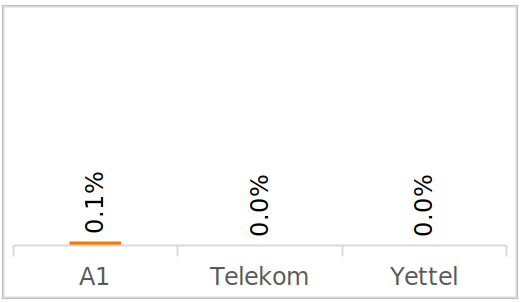
Telekom Srbija and Yettel had lack of dropped calls. A1 Srbija recorded one drop.
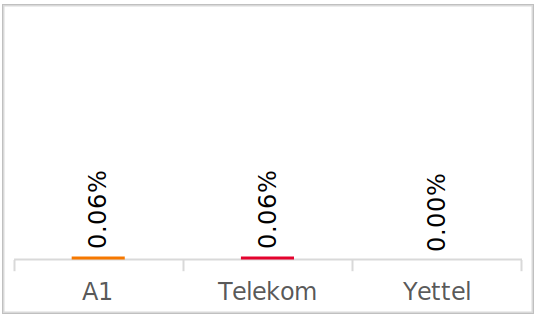
In Medium Cities, all operators had perfect call success rates. Telekom Srbija and A1 Srbija had one failed call.
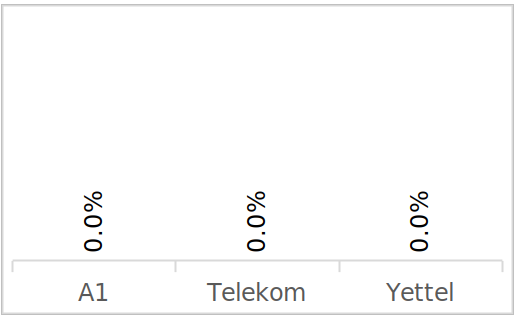
All three operators had lack of dropped calls recorded in Medium Cities.
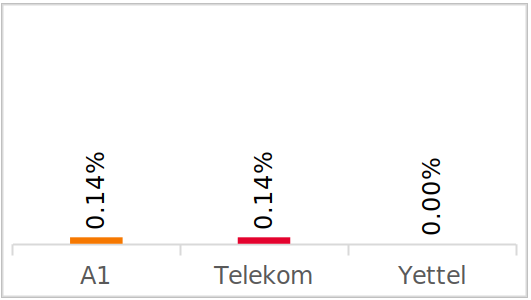
In Small Cities, all operators met the excellent call success rate. Yettel was without any failed call.
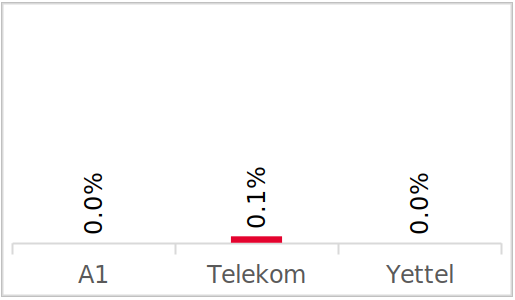
One dropped call occurred for Telekom Srbija in Small Cities aggregation.

On the Highways, all three operators had single failed calls recorded.
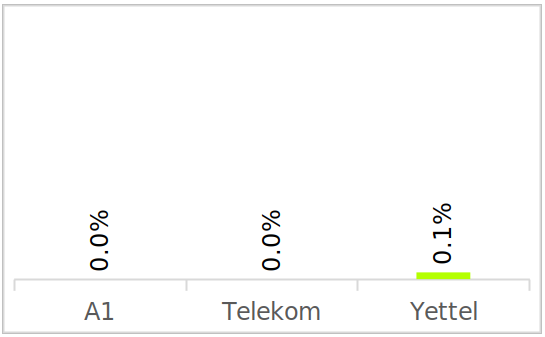
Yettel had one dropped call on Highways, Telekom Srbija and A1 Srbija were without any dropped call.
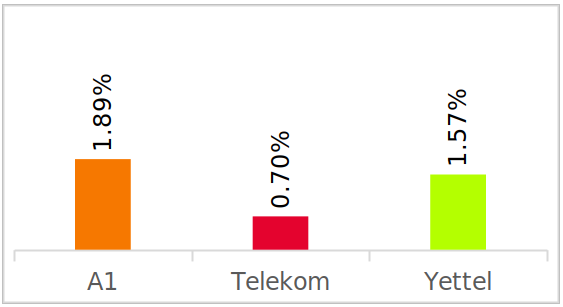
On Main Roads, all operators achieved good results. Telekom Srbija had the least number of failed calls.
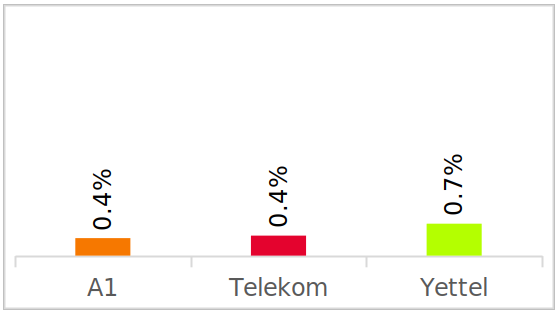
All operators had less than 1% of dropped calls, Yettel had the highest rate at 0.7%
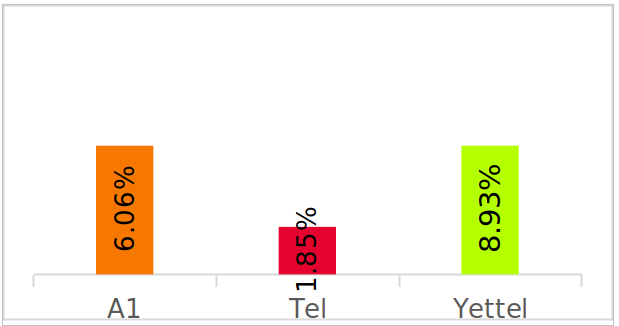
On the Rural Roads, all operators had the worse call setup success rates. Telekom Srbija had the least failed calls out of all three operators.
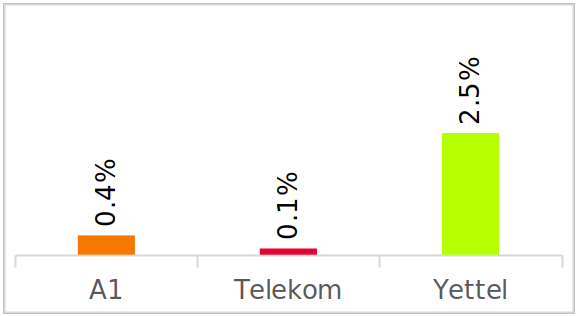
Telekom Srbija and A1 Srbija had the least number of dropped calls, Yettel had 2.5% dropped call rate.
Figure 2 below presents average call setup time values for all three operators in different aggregations.

Fig. 2. Average call setup time values
Telekom Srbija and A1 Srbija are ahead Yettel in Cities and on Roads, with the advantage of A1 Srbija where it’s average Call Setup Time is the shortest in all aggregations. Yettel had the longest average Call Setup Times, Telekom Srbija in between the competitors.
Distribution of call setup time duration in Big Cities for all three mobile operators is presented in Figure 3.
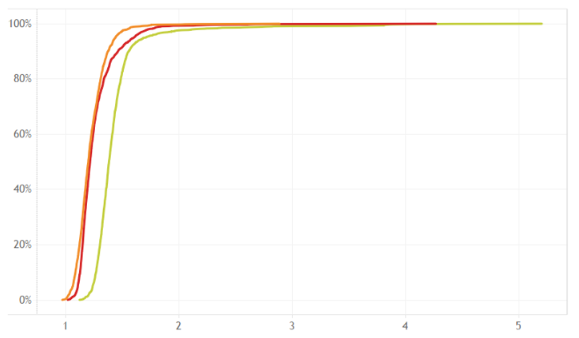
Fig. 3. Distribution of call setup time duration in Big Cities
Figure 4 below presents average MOS values for all three operators in different aggregations.
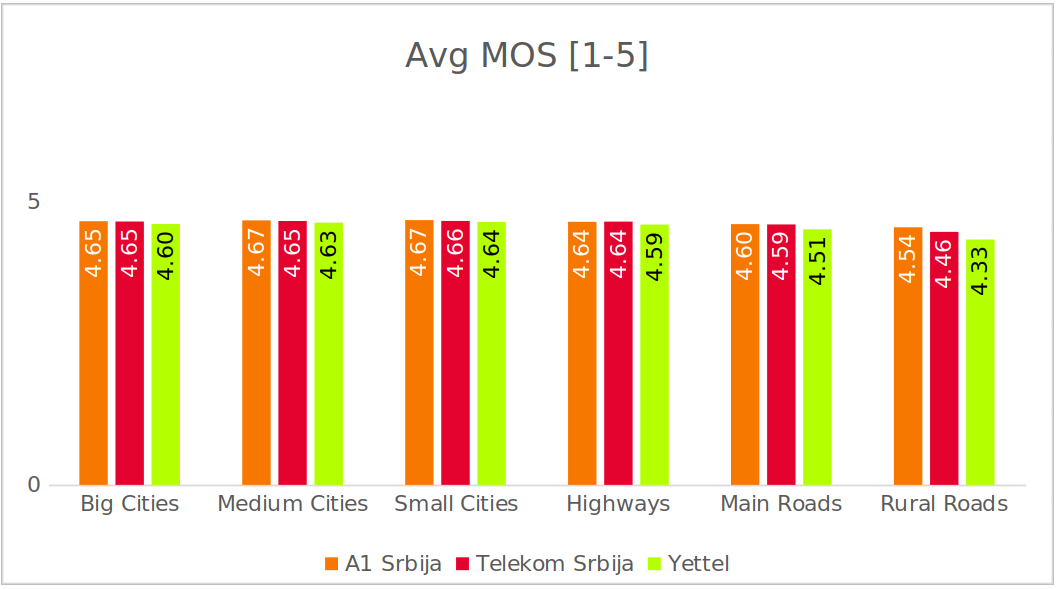
Fig. 4. Average MOS values
There is a variety of speech coding methods allowing transmission of the speech effectively. The use of codecs is determined by the quality of radio signal, available network technology and capacity of the network. Codecs offering the best speech quality require good radio conditions, reasonable radio resources and support of the codec by the network and mobile devices at both ends of the connection. In cases where the capacity of the network is limited, mobile operators use codecs with more efficient compression of the speech, but also providing worse speech quality. The distribution of the codecs used has a direct influence on the voice quality represented by MOS value (from 1 to 5, the best being 5). The EVS (Enhanced Voice Services) codec offers the best speech quality and was used by operators throughout all aggregations to the biggest extend.
Telekom Srbija and A1 Srbija had very close results in Cities and on Roads, where A1 Srbija had the best average MOS result on Rural Roads. Generally, results on Roads are slightly worse than in other aggregations, nevertheless on very good level for all operators where on Highways and Main Roads Telekom Srbija and A1 Srbija had almost equal average MOS. Yettel was slightly behind the competitors in all aggregations with more visible difference on Rural Roads, but on very good levels.
The results of the main KPIs for voice tests achieved by operators with the split per the aggregation type are presented in Figure 5.

Fig. 5. Results of main KPIs for voice tests
Railways:
Telekom Srbija had the best session success rate on railways. A1 Srbija had the second best result and Yettel was right behind. Overall, the session success rates are lower than in other aggregations mainly due to the tunnels and mountainous areas.
Hot Spots:
All operators achieved excellent session success rates. Overall, A1 Srbija had the shortest Call Setup Time with Telekom Srbija right behind, followed by Yettel. MOS result were almost equal for all three operators.
In Table 2, voice failed calls and dropped calls scores for all three operators, in different aggregations, are shown.
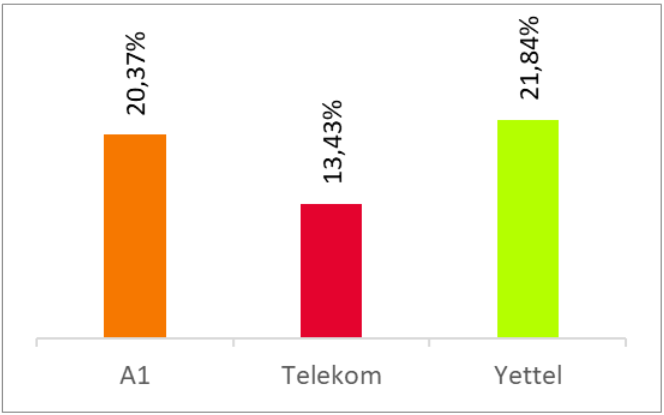
All three operators had the high failed calls rate on trains. Trains aggregation is the most challenging for service accessibility and reliability.
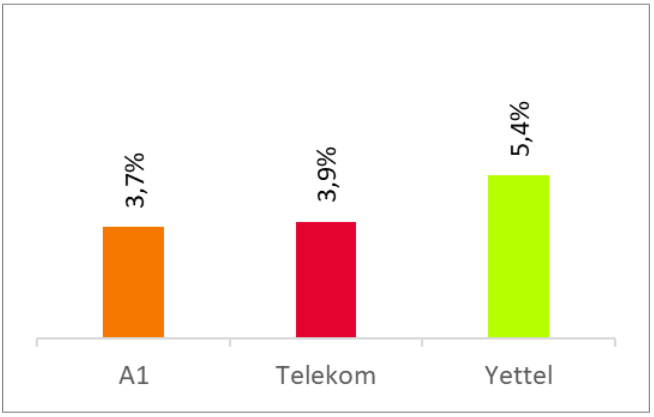
Yettel had the highest dropped calls rates, exceeding 5%, Telekom Srbija and A1 Srbija both exceeding 3%.
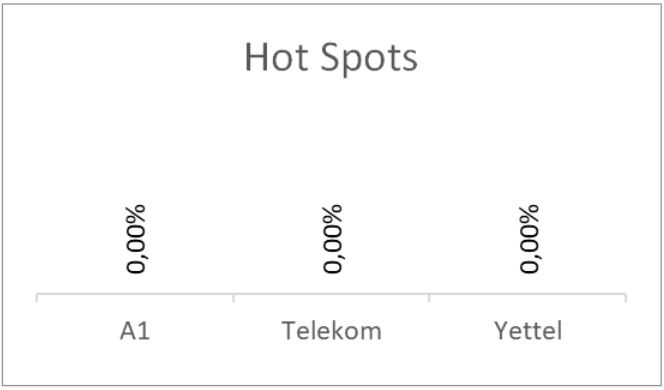
Hot Spots showed perfect success rates for all three operators, none failed call recorded.
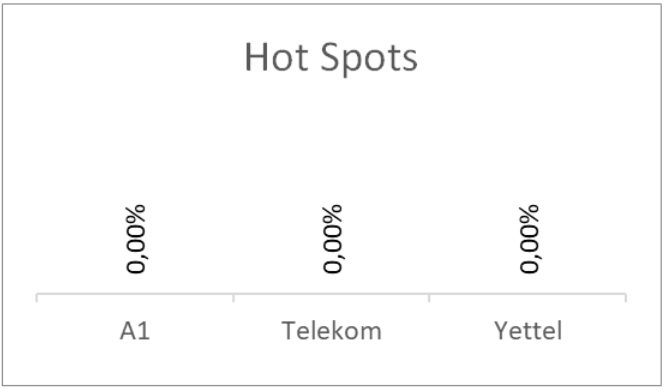
The excellent connection maintenance resulted in the lack of any dropped session for all three operators.
Figure 6 below presents average call setup time values for all three operators in different aggregations.

Fig. 6. Average call setup time values
A1 Srbija had slightly better average call setup time on Railways aggregation, almost equal to Telekom Srbija, leaving Yettel behind. In the Hot Spots aggregations, A1 Srbija had the best result, almost equal as Telekom Srbija, followed by Yettel.
Figure 7 below presents average MOS values for all three operators in different aggregations.

Fig. 7. Average MOS values
In Hot Spots areas, MOS results were almost equal for all three operators, where Telekom Srbija and A1 Srbija reaching 4.68 and Yettel at 4.67. Results on Railways were worse than in other aggregations, due to the demanding mountainous areas which resulted in lower MOS values, where Telekom Srbija had the best result at 4.45, A1 Srbija had the second best result at 4.37 and Yettel at 4.26.